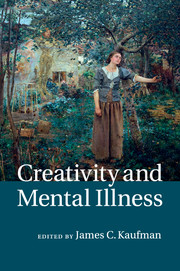Book contents
- Frontmatter
- Dedication
- Contents
- List of figures
- List of tables
- List of contributors
- Preface
- Acknowledgments
- Part I Creativity and mental illness: the state of the field
- Part II Cognitive and neuroscientific perspectives on creativity and mental illness
- Part III Creativity and the spectrum of mental illness
- Part IV Creativity and mental illness: possible commonalities
- Part V Creativity and mental health
- 15 Bringing the whole universe to order: creativity, healing, and posttraumatic growth1
- 16 Inspiration and the creative process1
- 17 King Solomon and psychoneuroimmunology: creativity and life coping
- Part VI Creativity and mental illness: what now?
- Index
- References
16 - Inspiration and the creative process1
from Part V - Creativity and mental health
Published online by Cambridge University Press: 05 August 2014
- Frontmatter
- Dedication
- Contents
- List of figures
- List of tables
- List of contributors
- Preface
- Acknowledgments
- Part I Creativity and mental illness: the state of the field
- Part II Cognitive and neuroscientific perspectives on creativity and mental illness
- Part III Creativity and the spectrum of mental illness
- Part IV Creativity and mental illness: possible commonalities
- Part V Creativity and mental health
- 15 Bringing the whole universe to order: creativity, healing, and posttraumatic growth1
- 16 Inspiration and the creative process1
- 17 King Solomon and psychoneuroimmunology: creativity and life coping
- Part VI Creativity and mental illness: what now?
- Index
- References
Summary
During his self-narrated journey through Purgatory in Part II of Divine comedy, Dante encounters a fellow poet, Donati Ferese, who ingratiates Dante with the following greeting: “[T]ell me if I see here the one who drew forth the new rhymes, beginning, ‘Ladies who have intellect of Love’?” Dante replies, “I in myself am one who, when Love breathes within me, takes note, and to that measure which he dictates within, I go signifying.” Ferese continues, “O my brother, now I see the knot that held Notary and Guittone and me back on this side of the sweet new style I hear. I see well how your pens follow close behind him who dictates, which with ours certainly did not happen” (Alighieri, 2003, Canto 24, p. 403).
It would be difficult to find in the literary canon a pithier portrayal of the role of inspiration in the creative process. Dante’s description of inspiration conveys its hallmark features – passive evocation (“when Love breathes within me”), transcendent awakening (“I…take note”), and motivation to express the content of the new awareness in concrete form (“I go signifying”). This passage also puts forth a provocative thesis: without inspiration, the writer produces a work of inferior quality. Although not universal, the belief that inspiration plays an important role in the creative process is widely held among writers and other creators (Fehrman, 1980; Harding, 1948). However, scientists traditionally have not invoked the inspiration concept in their theories or investigations of the creative process. In fact, some scientists (e.g., Sawyer, 2006) have portrayed inspiration as an outmoded explanation of creativity, a supernatural account that originated in ancient times and that has been perpetuated by Romantic poets and other creators.
- Type
- Chapter
- Information
- Creativity and Mental Illness , pp. 343 - 362Publisher: Cambridge University PressPrint publication year: 2014
References
- 3
- Cited by



